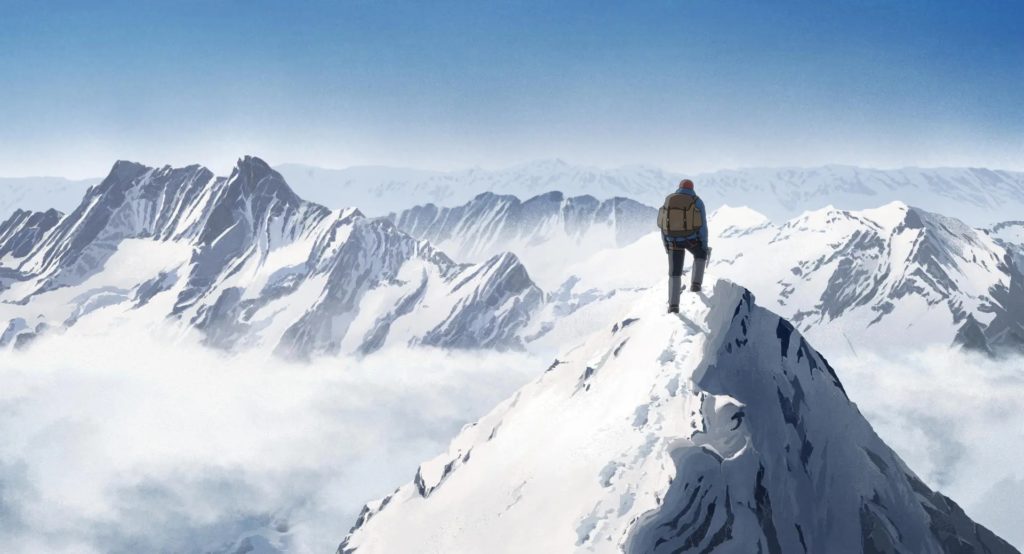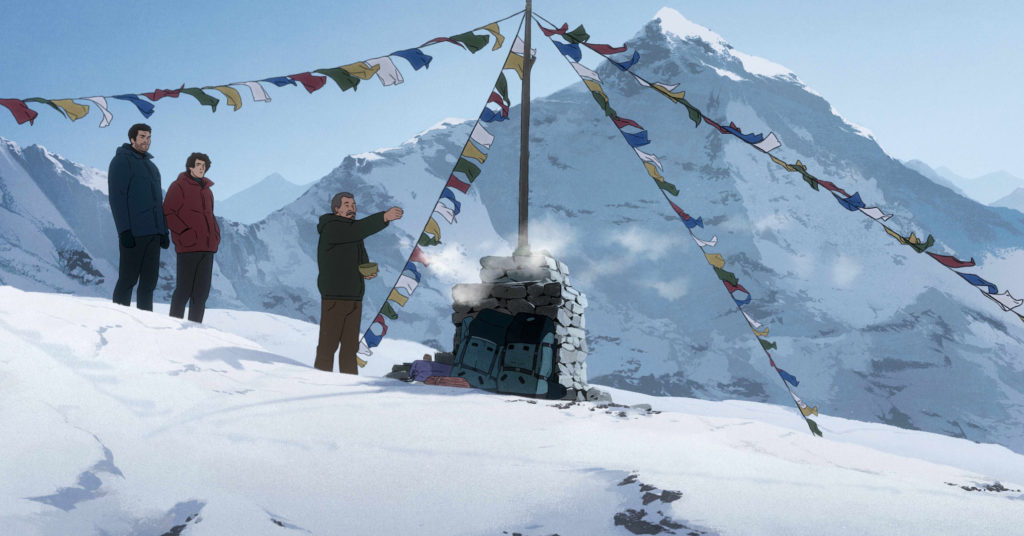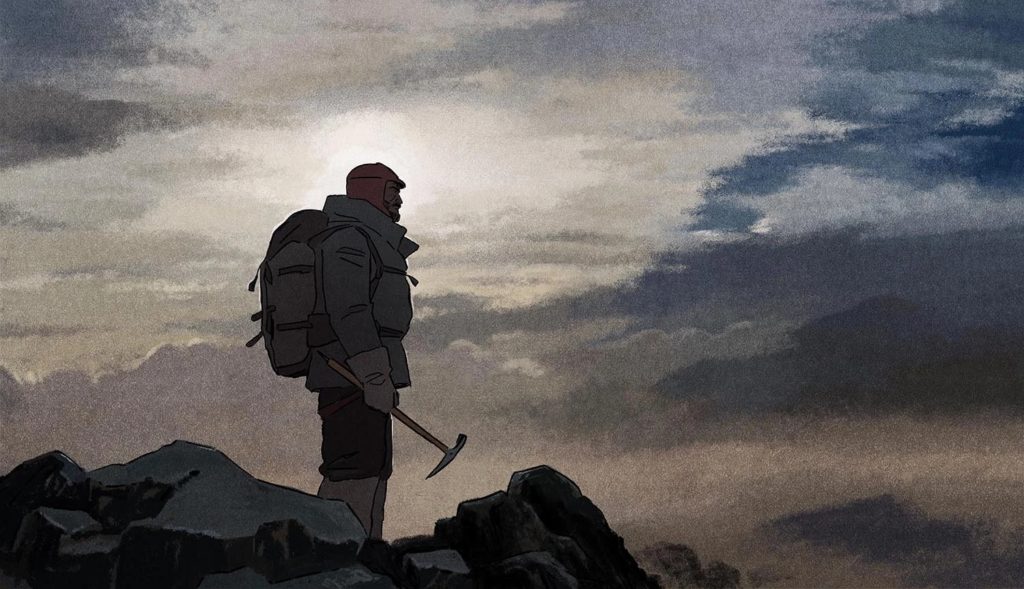Summit of the Gods
November 30, 2021 · 0 comments
By Andrew Osmond.

Animated characters are made out of ink or pixels, not flesh and blood, but that doesn’t mean the audience can’t feel their pain. There’s a moment in Perfect Blue where a character bellyflops on a shard of glass that still makes me wince. So does a scene in The Girl Who Leapt Through Time when the frantically running heroine trips on a sloping tarmac road and ends up in an ugly limb-scraping roll.
The Summit of the Gods, a French manga-based film just out on Netflix, is about mountaineering. That’s one of the most excruciating human endeavours imaginable: bone-smashing surfaces, knife-cold winds at hundreds of miles an hour, crunching headaches caused by oxygen depletion. A full-on depiction of the experience would be torture porn. The Summit of the Gods has three big sequences where mountaineering goes wrong, and they each operate differently.
The first is terrifying, dangling us over the abyss, but there’s little visceral pain. The second sequence is meant to be an ordeal, but it feels cushioned; we see someone suffer, but from a distance. It’s only in the third sequence that we “feel” the pain full on, largely through the animators bringing out tricks they’d eschewed till then; flashing lights, blurred pictures, and colour-coded agonies. Mercifully, it doesn’t last long.

Directed by Patrick Imbert, the film is the story of Joji Habu, an exceptionally driven man even among mountaineers, always pushing for the next slope, the next record. His exploits are framed as an investigation by the other protagonist, a newspaper photographer called Fukamichi who’s a mountaineer himself. There’s a touch of Citizen Kane in the set-up, about one man investigating another’s life, trying to find what makes his quarry tick – though in Summit, Fukamichi believes Habu’s still alive, after he vanished years ago.
There’s more to the framing story, as Fukamichi thinks Habu might have the answer to a mountaineering mystery. It’s a real-life mystery – was the first man to conquer Everest an Englishman called George Mallory? He was close to the summit in 1924 when he disappeared from the world, nearly thirty years before Everest’s first confirmed conquest. However, the film treats this subplot as a McGuffin that falls into irrelevance.
More important to the film is the “right” conduct in mountain climbing – whether, in the worst emergencies, it is every climber for himself. The hit 2003 documentary Touching the Void showed the situation of a climber forced to cut his partner loose. Sixty years ago, moral uncertainties blurred with suspected foul play in a 1961 Japanese mystery film, Death on the Mountain, directed by Toshio Sugie. In Summit, the issues’ treatment would look trite in a synopsis, but works when we’re fully immersed in the stormy climax. It’s a good, simple story and a good, simple film.

Summit of the Gods originated as a 1998 novel by Baku Yumemakura, who has written nearly three hundred books. However, the film’s credits specify it was adapted from a manga version of the novel, created by Jiro Taniguchi between 2000 to 2003. By the time the manga came out, the story’s Mallory subplot was already overtaken by real events. The animation is the second film based on the manga, following a live-action Japanese film in 2015 (here’s a spoiler-heavy trailer).
Taniguchi isn’t well-known to Anglophone fans, but he’s venerated in France, where he was knighted as a Chevalier of the Ordre des Artes et des Lettres. From the 1970s till his death in 2017, his work was associated with the more realistic type of manga stories, called gekiga. There aren’t many manga adaptations that are animated but not Japanese (that is, not anime). By coincidence, another example is the 2011 Singapore film Tatsumi, a celebration of the manga artist Yoshihiro Tatsumi, one of gekiga’s founders.
I’m not well up on the field, but Summit of the God’s images, particularly its character designs, reminded me of artists who are at least gekiga-adjacent, such as Naoki Urasawa (Monster) – though Urasawa told me he preferred just being called a manga artist, adding the same was true of Akira creator Katsuhiro Otomo. As it happens, a Tokyo bar scene in Summit of the Gods does feel especially Otomo-ish.

More obviously, Summit of the Gods uses the European ligne claire style of firm black character outlines, though not as overtly as the 2015 French animated film April and the Extraordinary World, which followed the style of Jacques Tardi. Summit’s characters are set against backgrounds that shine without the hyper-detail of Otomo or Shinkai, nor the ascetic minimalism of the French-animated The Red Turtle.
Instead, they’re in a pleasing middle ground where vivid colours, ranging from warm to freezing, predominate over little details. It’s an exceptionally handsome film, even if the character animation is unexceptional. The music by Amine Bouhafa enhances the images without intruding; in the mountain scenes, it feels like the slopes are singing.
The principal characters are all Japanese and many of the non-mountain scenes take place in Tokyo – though the characters take no interest in the city, so nor does the film. Still, it’s amusing to see lawyer-dodging fake corporate names, of the type common in anime, like “Longsan” (the Lawson convenience story) and “KHN” (the public broadcaster NHK). One tall flight of outdoors steps had me wondering if the film might be nodding to Your Name.
There’s no Japanese dub; Netflix offers an English-dubbed option, but I watched in the original French, and found that seeing French-speaking Japanese characters was a novelty in itself. As of writing, there are also a few screenings of the subtitled French version of Summit in some Curzon cinemas. I’d recommend that as a more immersive alternative to seeing the film on TV.
Despite the Tokyo scenes, and the visual congruence with Urasawa and Otomo, Summit doesn’t feel much like anime. Indeed, it reverses some more obvious conventions, with a protagonist who shuns allies and teamwork, and a cruel subversion of the old manga story of the boy who wants to be just like his hero. As for the challenges the characters face, I was reminded of one anime only: the science-fiction Planetes, which highlights the hazards of an environment even more dangerous than Everest’s death zone: outer space.
Andrew Osmond is the author of 100 Animated Feature Films. Summit of the Gods is in UK cinemas and on Netflix now.
Andrew Osmond, Baku Yumemakura, cinema, France, Jiro Taniguchi, Patrick Imbert, Summit of the Gods
Leave a Reply